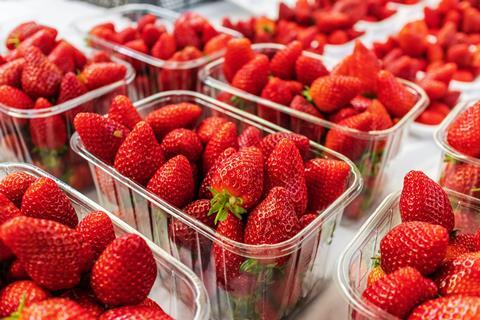Shopping frequency hits highest level since March 2020 with fresh fruit such as strawberries among the biggest winners

Grocery footfall hit a five-year high in June as take-home grocery sales grew by 4.1 per cent year on year, according to Kantar.
The jump in shopping frequency in the four weeks to 15 June came despite another rise in grocery price inflation, which hit 4.7 per cent, its highest level since February 2024. This is up from 4.1 per cent in May.
Fraser McKevitt, head of retail and consumer insight at Kantar, said: “Higher prices didn’t stop shoppers making 490 million trips to the supermarket over the latest month, averaging almost 17 per British household. That’s the highest we’ve recorded since March 2020.
“As the sun tempted more people out, fresh fruit sales were one of the biggest winners. Consumers bought 2,400 packs of strawberries every minute in the last four weeks. People are trading up to more exotic fruits too, with sales of mangoes and blueberries climbing by 27 per cent and 10 per cent each.”
Drop in average spend
The rise in purchase frequency was balanced out by a drop in average trip spend, which fell back by three pence to £23.89.
McKevitt said: “Consumer concerns over price are continuing, and this is reflected in the figures. Sales of own-label ranges grew at 4.2 per cent this month, ahead of branded lines, as shoppers looked to balance their budgets.
“Deals also remain an important tool for retailers to offer value and the proportion of spending on promotion stepped up to 28.8 per cent this period.”
Slight fall in grocery volumes
Overall grocery volumes fell slightly by 0.4 per cent in the four weeks to 15 June, the first year-on-year decline of the year. A small part of this fall could also be down to changing health priorities such as the growing use of GLP-1 weight loss drugs, Kantar said.
McKevitt explained: “Supermarkets and grocery brands are entering new territory as weight loss drugs become more popular, with four in 100 households in Great Britain now including at least one GLP-1 user, according to Kantar research.
“That’s almost twice as many as last year, so while it’s still pretty low, it’s definitely a trend that the industry should keep an eye on as these drugs have the potential to steer choices at the till.”
Ocado still fastest-growing retailer
Continuing to lead the pack, Ocado was the fastest-growing grocer, with sales up 12.2 per cent in the 12 weeks to 15 June 2025. Its growth continues to be driven by more frequent visits to the online store, and strong performance within its traditional heartlands of London and southern England. Ocado’s hold of the market now sits at 1.9 per cent.
Among bricks-and-mortar grocers, Lidl was the fastest growing at 11.2 per cent – its third consecutive month of double-digit growth. Lidl’s portion of the market reached 8.1 per cent, an increase of 0.4 percentage points on this time last year.
Fellow discounter Aldi increased its share to 10.9% as sales rose by 6.5%.
Spending at Tesco accelerated to seven per cent, with the grocer seeing the highest share gain over the 12-week period, at 0.5 percentage points, taking it to 28.1 per cent.
Sainsbury’s’ share also nudged up to 15.2 per cent, as sales grew by 5.7 per cent. Morrisons now holds 8.4 per cent of the market, with spending rising by 2.2 per cent.
Asda’s market share stands at 11.9 per cent with sales through the tills 1.7 per cent lower than a year ago, but this does represent an improving trend as the Leeds-based retailer looks to return to growth over the summer months.
Meanwhile, Waitrose boosted its sales by 5.5 per cent – the highest since March 2021, meaning it now holds a 4.5 per cent portion.
Convenience retailer Co-op accounts for a 5.3 per cent share, while frozen food specialist Iceland retains 2.3 per cent with sales climbing by 1.9 per cent.
Spending on groceries at M&S rose by 12 per cent over the same period.



